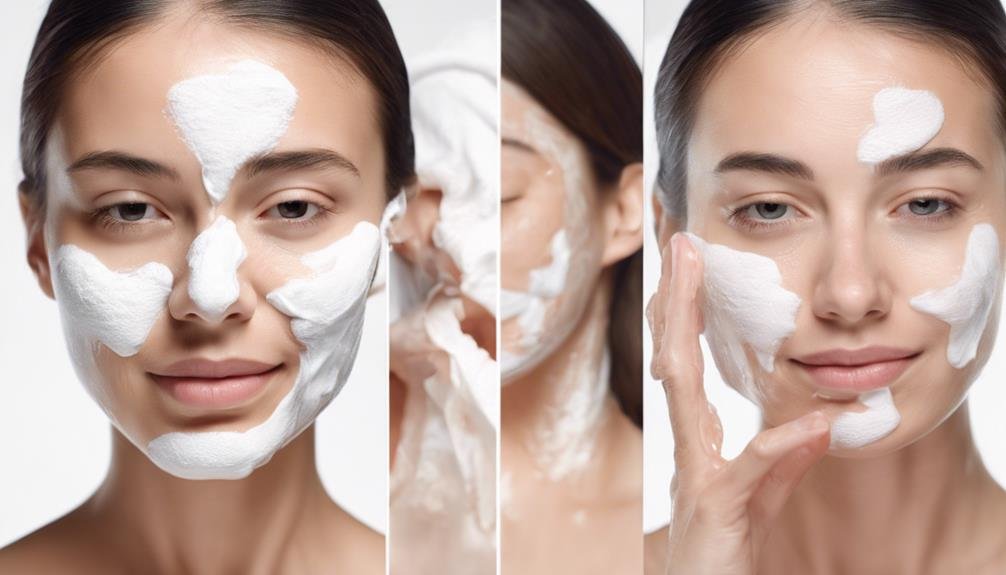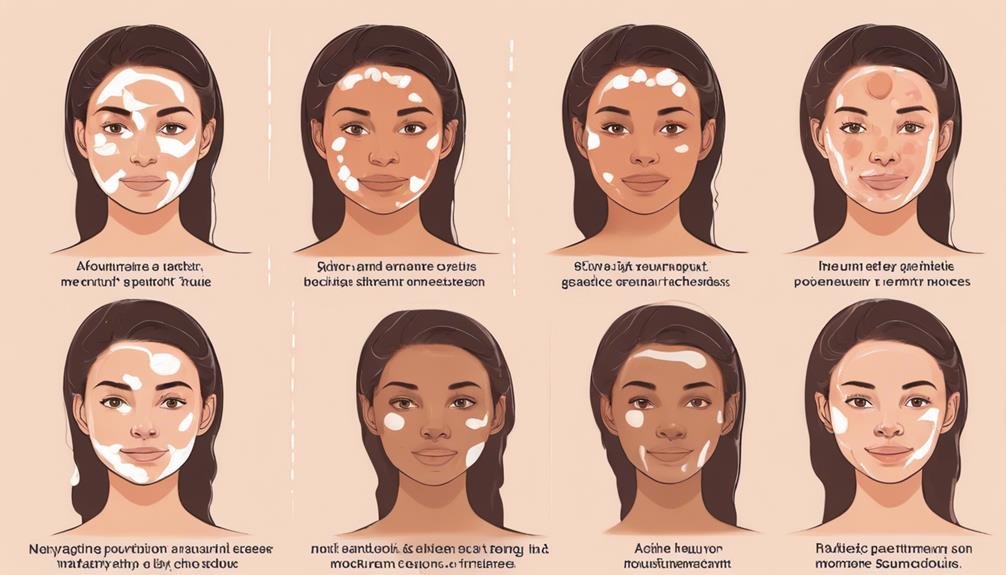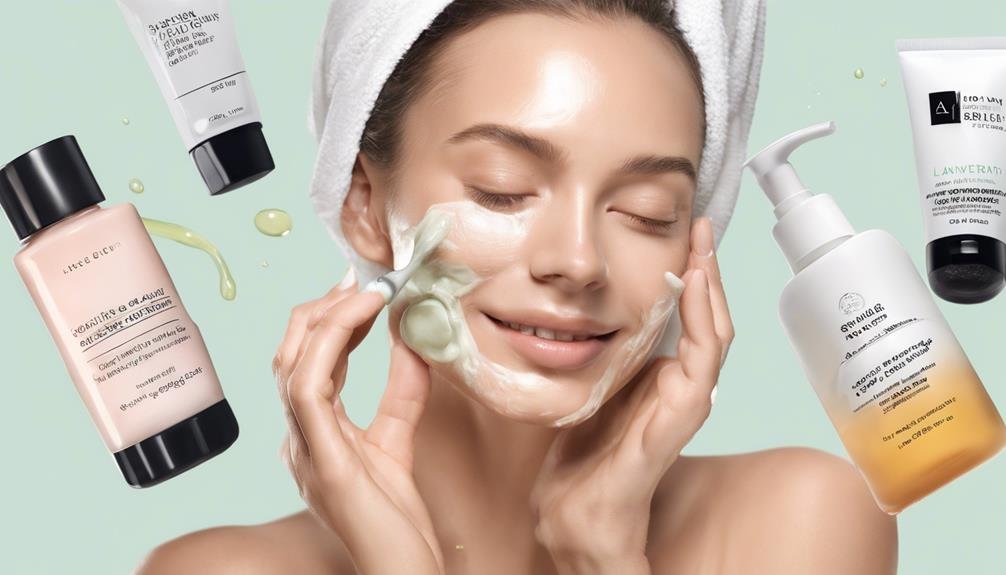Navigating the complexities of combination skin can be a challenge, but with the right approach, you can achieve a harmonious balance. Understanding the unique needs of your T-zone and dry areas is just the beginning. By implementing targeted skincare techniques and selecting suitable products, you can effectively manage the dual nature of your skin. Stay tuned to uncover practical tips and expert advice on how to address the specific concerns of combination skin and achieve a radiant complexion that defies the odds.
Understanding Combination Skin
If you're one of the many individuals grappling with combination skin, you aren't alone. Understanding this skin type is crucial for developing an effective skincare routine that caters to its unique needs. Combination skin is characterized by having both oily areas, typically in the T-zone (forehead, nose, and chin), and dry patches in other areas of the face.
When it comes to your skincare routine, it's essential to strike a balance between addressing the oily areas without drying out the dry patches. Opt for a gentle cleanser that can remove excess oil without stripping the skin of its natural moisture.
Incorporating a lightweight, oil-free moisturizer will help hydrate the dry areas without adding extra shine to the oily zones.
Product recommendations for combination skin often include:
- Gel-based cleansers
- Hydrating serums with hyaluronic acid
- Non-comedogenic moisturizers
Additionally, using a targeted treatment like salicylic acid for the oily regions and a richer cream for the dry areas can help maintain harmony in your skin. Remember, consistency in your skincare routine is key to managing combination skin effectively.
Identifying Your Skin Type
Determining your skin type is a foundational step in establishing an effective skincare regimen tailored to your specific needs. To identify your skin type, start by observing how your skin behaves throughout the day. Combination skin typically has an oily T-zone (forehead, nose, and chin) while being normal or dry on the cheeks. Take note of any areas that feel oily, dry, or balanced.
Once you determine your skin type, you can tailor your skincare routines accordingly. For combination skin, a gentle cleanser, lightweight moisturizer, and targeted treatments for different areas can be beneficial.
When it comes to makeup application, choose products designed for combination skin to ensure a balanced look that lasts throughout the day. Consider using a mattifying primer on the T-zone and a hydrating foundation on the cheeks to address different skin needs.
Understanding your skin type is the first step towards achieving a healthy complexion. By incorporating suitable products into your skincare routines and makeup application, you can effectively manage combination skin for a radiant appearance.
Gentle Cleansing Techniques
When it comes to caring for combination skin, gentle cleansing techniques play a crucial role in maintaining a healthy balance. Your daily routine should involve a gentle cleanser that effectively removes dirt and excess oil without stripping your skin of its natural moisture. Proper cleansing helps in balancing the hydration levels of both dry and oily areas on your face, ensuring a harmonious complexion.
Below is a table outlining some gentle cleansing techniques to incorporate into your skincare routine:
| Gentle Cleansing Techniques | Description |
|---|---|
| Double Cleansing | Using an oil-based cleanser followed by a gentle foaming cleanser to remove impurities thoroughly. |
| Micellar Water | A gentle water-based cleanser that effectively cleanses skin without drying it out. |
| Exfoliating Scrubs | Using mild exfoliants to remove dead skin cells and unclog pores, promoting a clearer complexion. |
| Cream Cleansers | Hydrating cleansers that nourish the skin while cleansing, ideal for maintaining hydration balance. |
| Cleansing Brushes | Electric or manual brushes that help in deep cleansing while being gentle on the skin. |
Moisturizing Tips for Balance
To achieve a harmonious balance in caring for your combination skin, mastering effective moisturizing tips is essential. Hydration secrets play a crucial role in ensuring that both the dry and oily areas of your skin receive the nourishment they need. Opt for a lightweight, oil-free moisturizer to hydrate without clogging pores. Look for ingredients like hyaluronic acid and glycerin, which help retain moisture without adding excess oil.
In addition to hydration secrets, incorporating oil control strategies is vital for managing combination skin. Choose a moisturizer specifically formulated to target oily areas, such as those containing salicylic acid or tea tree oil. These ingredients can help regulate oil production and prevent breakouts in those areas.
Targeted Skincare Products
For addressing the specific needs of combination skin, incorporating targeted skincare products can be highly beneficial. When it comes to product selection and ingredient analysis, it's crucial to choose wisely to cater to the varying requirements of your skin.
Here are some tips to help you navigate the world of targeted skincare for combination skin:
- Choose Multi-Tasking Products: Opt for skincare items that specifically target both oily and dry areas. Look for products that balance hydration without clogging pores, such as lightweight gel moisturizers or serums.
- Focus on Key Ingredients: Ingredients like hyaluronic acid, niacinamide, and salicylic acid can work wonders for combination skin. Hyaluronic acid hydrates without adding excess oil, niacinamide helps regulate sebum production, while salicylic acid unclogs pores and exfoliates dead skin cells.
- Consider Customized Solutions: Some brands offer customizable skincare solutions tailored to your skin type. Consider investing in personalized skincare formulations to address the unique needs of your combination skin effectively.
Sun Protection Essentials
Sun protection is crucial for maintaining healthy skin, especially for individuals with combination skin. Proper sunscreen application is key to shield your skin from harmful UV rays and prevent early signs of aging and skin damage. When selecting a sunscreen, opt for a broad-spectrum formula with an SPF of at least 30 for daily use. Here are some SPF recommendations based on your skin type:
| Skin Type | Recommended SPF |
|---|---|
| Combination | SPF 30-50 |
| Dry | SPF 30-50 |
| Oily | SPF 30-50 |
For combination skin, a broad-spectrum sunscreen with an SPF of 30 to 50 is ideal. Remember to reapply your sunscreen every two hours, especially when outdoors or after sweating. Make sun protection a non-negotiable step in your skincare routine to maintain healthy and radiant skin.
Managing Breakouts and Dry Patches
Amidst the complexities of combination skin, managing breakouts and dry patches requires a tailored approach that addresses both concerns effectively. When it comes to dealing with breakouts and dry patches, a consistent skincare routine and the right products can make a significant difference in achieving balance and healthy skin. Here are some tips to help you manage these issues:
- Skincare Routines: Establish a skincare routine that includes gentle cleansing, exfoliation to unclog pores, and hydration to combat dry patches. Consistency is key to seeing improvements in your skin's condition.
- Product Recommendations: Look for skincare products that are non-comedogenic to prevent breakouts and hydrating to combat dryness. Ingredients like salicylic acid can help with breakouts, while hyaluronic acid can provide moisture without clogging pores.
- Targeted Treatments: Consider using spot treatments for breakouts and richer moisturizers for dry patches. Spot treatments with benzoyl peroxide or tea tree oil can help clear up acne, while heavier creams can provide relief for dry areas.
Diet and Lifestyle Considerations
Considering the impact of diet and lifestyle on your combination skin can provide valuable insights into maintaining a healthy complexion. Your nutrition choices play a significant role in the health of your skin. Including foods rich in antioxidants like fruits and vegetables, as well as omega-3 fatty acids found in fish, can help combat inflammation and promote skin health. Additionally, staying hydrated by drinking plenty of water is essential for keeping your skin hydrated and supple.
Maintaining good exercise habits is also crucial for managing combination skin. Regular physical activity helps improve circulation, which in turn can enhance the delivery of nutrients to your skin cells. Sweating during exercise can also help flush out toxins from your body, contributing to clearer skin.
| Nutrition Choices | Exercise Habits |
|---|---|
| Antioxidant-rich foods | Regular physical activity |
| Omega-3 fatty acids | Improved circulation |
| Hydration through water | Sweating for detoxification |
Consistency Is Key
Throughout your skincare journey, one fundamental principle remains constant: consistency is key. To effectively manage combination skin, it's crucial to maintain a regular routine that caters to its unique needs. Here are some essential tips to help you stay consistent in your skincare regimen:
- Product layering: Layering your skincare products in the correct order can enhance their effectiveness and ensure that each product penetrates the skin properly. Consistently following a specific sequence can maximize the benefits of your skincare routine.
- Hydration levels: Consistency in hydrating your skin is vital for maintaining its balance, especially for combination skin. By regularly moisturizing and using hydrating products, you can help prevent dryness in certain areas and control excess oil in others.
- Routine maintenance: Regularly assessing your skin's condition and adjusting your skincare routine accordingly is crucial for managing combination skin. Consistency in monitoring how your skin responds to different products and making necessary changes will help you maintain a balanced and healthy complexion.
Frequently Asked Questions
Can Combination Skin Change With Age or Hormonal Fluctuations?
Yes, combination skin can indeed change due to age or hormonal fluctuations. These factors can impact oil production and hydration levels in different areas of your face. Adapting your skincare routine to address these changes is essential for balance.
Is It Possible to Have Combination Skin Only in Certain Areas?
You can have combination skin only in specific areas, like an oily T-zone and dry cheeks. Adjust skincare routines by using different products for various zones. Blend foundation seamlessly for makeup application, ensuring a balanced and flawless look.
How Do Environmental Factors Like Weather Affect Combination Skin?
Weather can impact your combination skin by causing dryness or excess oiliness. Adjust your skincare routines based on the climate. Use lightweight hydrating products in humid weather and richer moisturizers in dry conditions. Choose makeup products that are suitable for all skin types.
Can Stress and Lack of Sleep Impact Combination Skin?
Stress and lack of sleep can definitely impact combination skin. Your body's response to stress can trigger hormone fluctuations and increase oil production, leading to breakouts. Ensure a balanced diet, a consistent skincare routine, and prioritize rest for healthier skin.
What Role Does Exfoliation Play in Managing Combination Skin?
To manage combination skin, exfoliation is crucial. Chemical exfoliation dissolves dead skin cells, unclogs pores, and evens out skin texture. Physical exfoliation, like scrubs, buffs away impurities. Incorporate both methods weekly for a balanced complexion.
Conclusion
In conclusion, managing combination skin requires a tailored approach that balances the needs of oily and dry areas. By incorporating gentle cleansing techniques, targeted skincare products, and consistent routines, you can achieve a healthy complexion. Remember, consistency is key in achieving skin harmony. So, don't be afraid to pamper your skin with the right products and care – your skin will thank you with a radiant glow that will make heads turn!







